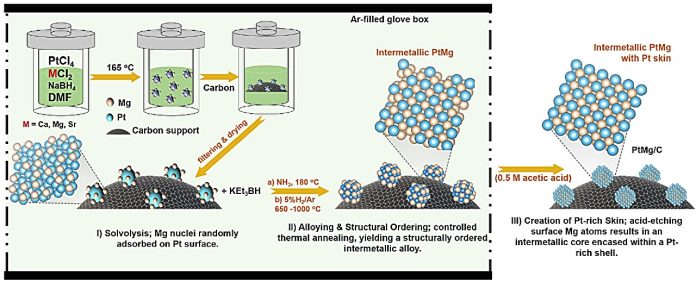
Researchers from the Daegu Gyeongbuk Institute of Science and Technology have developed a groundbreaking fuel cell catalyst made from a new alloy of platinum and magnesium.
This new catalyst, which uses the world’s first platinum-magnesium alloy nanoparticles, is expected to greatly improve the efficiency and durability of fuel cells, a key technology in clean energy.
The team’s findings were published in the journal Nature Communications.
Fuel cells work by combining hydrogen and oxygen to produce electricity, and platinum is typically used as a catalyst to speed up these reactions.
However, platinum is costly, which has been a major challenge for making fuel cells more affordable.
By adding magnesium to the alloy, the researchers have not only reduced costs but also improved how efficiently the fuel cell works and how long it lasts.
For years, scientists have known that platinum alloys with alkaline earth metals, like magnesium, hold great promise for fuel cells due to their ability to boost catalytic activity and stability.
But turning these materials into nanoparticles has been a big challenge because of the high reactivity of alkaline earth metals.
That’s why this new discovery is so important—the researchers, led by Professor Jong-Sung Yu, found a way to create platinum-magnesium nanoparticles using a special solution-phase method.
What makes this new alloy so special?
Theoretical studies from the University of Texas at Austin show that the combination of platinum and magnesium creates a strong synergy that keeps the alloy stable for a long time.
This means the catalyst won’t break down quickly, which is important for making fuel cells last longer and perform better over time.
In real-world tests, the new platinum-magnesium alloy exceeded the U.S. Department of Energy’s 2025 performance targets for fuel cells, showing high efficiency and long-lasting durability. “Most fuel cell catalysts struggle with durability and cost, but our platinum-magnesium nanoparticles solve these issues by combining platinum’s speed with magnesium’s strength and affordability,” said Professor Jong-Sung Yu, who led the research team. This development could significantly improve the practicality of fuel cells for a range of applications, from powering vehicles to providing clean energy for homes and businesses.
In addition to improving fuel cells, this new alloy could also be useful in other energy technologies, such as hydrogen production and various electrochemical reactions. Caleb Gyan-Barimah, the first author of the study, said, “This isn’t just about making fuel cells better. This technology could also lead to advancements in other areas of clean energy.”
As the world moves towards more sustainable energy sources, innovations like this are crucial. The researchers plan to continue improving the alloy and work on ways to scale up production. They also hope to partner with industry and government to bring this exciting new technology to the market.



